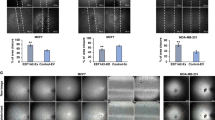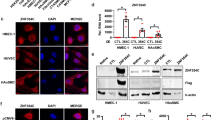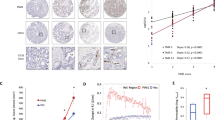Abstract
Tumor suppressor p53 has been shown to repress expression of vascular endothelial growth factor (VEGF), an endothelial cell-specific mitogen and a key mediator of tumor angiogenesis. The p63 gene, recently identified as a p53-relative, encodes multiple isoforms with structural and functional similarities and differences from p53. In this study, we show the evidence that the two major isoforms of the p63 gene, TAp63γ (p51A) and dNp63α (p73L), represses and upregulates VEGF expression, respectively, on transcription and protein levels. Transient transfection assays show that a hypoxia-inducible factor (HIF) 1 binding site within the VEGF promoter region is responsible for both upregulation and repression by dNp63α and by TAp63γ, respectively, of the VEGF promoter activity. We also show that TAp63γ targets HIF1α for promoting proteasomal degradation but that dNp63α targets HIF1α for stabilization. Mammalian two-hybrid assays show that HIF1α-dependent transcription is repressed by TAp63γ as well as by p53, whereas it is upregulated by dNp63α in collaboration with a transcription coactivator p300. Our data also show that dNp63α acts as a dominant-negative reagent toward both p53- and TAp63γ-mediated degradation of HIF1α and repression of HIF1α-dependent transcription. These results suggest that p63 is involved in the regulation of the VEGF gene expression and that modulation of VEGF expression by TAp63γ and dNp63α is closely correlated with their distinct roles on the regulation of HIF1α stability.
This is a preview of subscription content, access via your institution
Access options
Subscribe to this journal
Receive 50 print issues and online access
$259.00 per year
only $5.18 per issue
Buy this article
- Purchase on Springer Link
- Instant access to full article PDF
Prices may be subject to local taxes which are calculated during checkout








Similar content being viewed by others
References
Arany Z, Huang LE, Eckner R, Bhattacharya S, Jiang C, Goldberg MA, Bunn HF, Livingston DM . 1996 Proc. Natl. Acad. Sci. USA 93: 12969–12973
Blagosklonny MV, An WG, Romanova LY, Trepel J, Fojo T, Neckers L . 1998 J. Biol. Chem. 273: 11995–11998
Bunn HF, Poyton RO . 1996 Physiol. Rev. 76: 839–885
Bouvet M, Ellis LM, Nishizaki M, Fujiwara T, Liu W, Bucana CD, Fang B, Lee JJ, Roth JA . 1998 Cancer Res. 58: 2288–2292
Crook T, Nicholls JM, Brooks L, O'Nions J, Allday MJ . 2000 Oncogene 19: 3439–3444
Dohn M, Zhang S, Chen X . 2001 Oncogene 20: 3193–3205
Ema M, Hirota K, Mimura J, Abe H, Yodoi J, Sogawa K, Poellinger L, Fujii-Kuriyama Y . 1999 EMBO J. 18: 1905–1914
Finkenzeller G, Technau A, Marme D . 1995 Biochem. Biophys. Res. Commun. 208: 432–439
Folkman J . 1997 Tumor angiogenesis In Cancer Medicine pp 181–204 Baltimore, MD: Williams & Wilkins
Fontanini G, Boldrini L, Vignati S, Chine S, Basolo F, Silvestri V, Lucchi M, Mussi A, Angeletti CA, Bevilacqua G . 1998 Eur. J. Cancer 34: 718–723
Forsythe JA, Jiang BH, Iyer NV, Agani F, Leung SW, Koos RD, Semenza GL . 1996 Mol. Cell. Biol. 16: 4604–4613
Gleadle JM, Ebert BL, Firth JD, Ratcliffe PJ . 1995 Am. J. Physiol. 268: C1362–C1368
Goldberg MA, Schneider TJ . 1994 J. Biol. Chem. 269: 4355–4359
Hibi K, Trink B, Patturajan M, Westra WH, Caballero OL, Hill DE, Ratovitski EA, Jen J, Sidransky D . 2000 Proc. Natl. Acad. Sci. USA 97: 5462–5467
Huang EL, Gu J, Schau M, Bunn HF . 1998 Proc. Natl. Acad. Sci. USA 95: 7987–7992
Ikeda E, Achen MG, Breier G, Risau W . 1995 J. Biol. Chem. 270: 19761–19766
Iyer NV, Kotch LE, Agani F, Leung SW, Laughner E, Wenger RH, Gassmann M, Gearhart JD, Lawler AM, Yu AY, Semenza GL . 1998 Genes Dev. 12: 149–162
Kallio PJ, Okamoto K, O'Brien S, Carrero P, Makino Y, Tanaka H, Pollinger L . 1998 EMBO J. 17: 6573–6586
Kallio PJ, Wilson WJ, O'Brien S, Makino Y, Poellinger L . 1999 J. Biol. Chem. 274: 6519–6525
Kanegae Y, Lee G, Sato Y, Tanaka M, Nakai M, Sakaki T, Sugano S, Saito I . 1995 Nucleic Acids Res. 23: 3816–3821
Kanegae Y, Takamori K, Sato Y, Lee G, Nakai M, Saito I . 1996 Gene 181: 207–212
Kotch LE, Iyer NV, Laughner E, Semenza GL . 1999 Dev. Biol. 209: 254–267
Levy AP, Levy NS, Wegner S, Goldberg MA . 1995 J. Biol. Chem. 270: 13333–13340
Liu Y, Cox SR, Morita T, Kourembanas S . 1995 Circ. Res. 77: 638–643
Martiny-Baron G, Marme D . 1995 Curr. Opin. Biotechnol. 6: 675–680
Mitsudomi T, Steinberg SM, Nau MM, Carbone D, D'Amico D, Bodner S, Oie HK, Linnoila RI, Mulshine JL, Minna JD, Gazdar AF . 1992 Oncogene 7: 171–180
Mukhopadhyay D, Tsiokas L, Sukhatme VP . 1995 Cancer Res. 55: 6161–6165
Nishi H, Isaka K, Sagawa Y, Usuda S, Fujito A, Ito H, Senoo M, Kato H, Takayama M . 1999 Int. J. Oncol. 15: 1149–1153
Nishi H, Senoo M, Nishi KH, Murphy B, Rikiyama T, Matsumura Y, Habu S, Johnson AC . 2001 J. Biol. Chem. 276: 41717–41724
Niwa H, Yamamura K, Miyazaki J . 1991 Gene 108: 193–200
Nylander K, Coates PJ, Hall PA . 2000 Int. J. Cancer 87: 368–372
Osada M, Ohba M, Kawahara C, Ishioka C, Kanamaru R, Katoh I, Ikawa Y, Nimura Y, Nakagawara A, Obinata M, Ikawa S . 1998 Nature Med. 4: 839–843
Park BJ, Lee SJ, Kim JI, Lee SJ, Lee CH, Chang SG, Park JH, Chi SG . 2000 Cancer Res. 60: 3370–3374
Ravi R, Mookerjee B, Bhujwalla ZM, Sutter CH, Artemov D, Zung Q, Dillehay LE, Madan A, Semenza GL, Bedi A . 2000 Genes Dev. 14: 34–44
Salimath B, Marme D, Finkenzeller G . 2000 Oncogene 19: 3470–3476
Salceda S, Caro J . 1997 J. Biol. Chem. 272: 22642–22647
Schmale H, Bamberger C . 1997 Oncogene 15: 1363–1367
Semenza GL . 1998 Curr. Opin. Genet. Dev. 8: 588–594
Semenza GL . 1999 Annu. Rev. Cell Dev. Biol. 15: 551–578
Senoo M, Seki N, Ohira M, Sugano S, Watanabe M, Inuzuka S, Okamoto T, Tachibana M, Tanaka T, Shinkai Y, Kato H . 1998 Biochem. Biophys. Res. Commun. 248: 603–607
Senoo M, Tsuchiya I, Matsumura Y, Mori T, Saito Y, Kato H, Okamoto H, Habu S . 2001a Br. J. Cancer 84: 1235–1241
Senoo M, Matsumura Y, Habu S . 2001b Biochem. Biophys. Res. Commun. 286: 628–634
Shima DT, Kuroki M, Deutsch U, Ng YS, Adamis AP, D'Amore PA . 1996 J. Biol. Chem. 271: 3877–3883
Shimada A, Kato S, Enjo K, Osada M, Ikawa Y, Kohno K, Obinata M, Kanamaru R, Ikawa S, Ishioka C . 1999 Cancer Res. 59: 2781–2786
Shweiki D, Itin A, Soffer D, Keshet E . 1992 Nature 359: 843–845
Sunahara M, Shishikura T, Takahashi M, Todo S, Yamamoto N, Kimura H, Kato S, Ishioka C, Ikawa S, Ikawa Y, Nakagawara A . 1999 Oncogene 18: 3761–3765
Suzuki K, Hayashi N, Miyamoto Y, Yamamoto M, Ohkawa K, Ito Y, Sasaki Y, Yamaguchi Y, Nakase H, Noda K, Enomoto K, Arai Y, Yamada H, Yoshihara T, Tujimura K, Kawano K, Yoshikawa N, Kamada T . 1996 Cancer Res. 56: 3004–3009
Trink B, Okami K, Wu L, Sriuranpong V, Jen J, Sidransky D . 1998 Nature Med. 4: 747–
Wang GL, Jiang BH, Rue EA, Semenza GL . 1995 Proc. Natl. Acad. Sci. USA 92: 5510–5154
Wenger RH, Gassmann M . 1997 Biol. Chem. 378: 609–616
Yang A, Kaghad M, Wang Y, Gillett E, Fleming MD, Dotsch V, Andrews NC, Caput D, McKeon F . 1998 Mol. Cell 2: 305–316
Zong H, DeMarzo AM, Laughner E, Lim M, Hilton A, Zagzag D, Buechler P, Isaacs WB, Semenza GL, Simons JW . 1999 Cancer Res. 59: 5830–5835
Acknowledgements
We thank Drs GL Semenza, PA D'Amore and S Ishii for providing the plasmids. We also thank T Matsumura for help in establishing the inducible H1299 cell lines. This work was partially supported by 2001 Tokai University School of Medicine Research Aid.
Author information
Authors and Affiliations
Corresponding author
Rights and permissions
About this article
Cite this article
Senoo, M., Matsumura, Y. & Habu, S. TAp63γ (p51A) and dNp63α (p73L), two major isoforms of the p63 gene, exert opposite effects on the vascular endothelial growth factor (VEGF) gene expression. Oncogene 21, 2455–2465 (2002). https://doi.org/10.1038/sj.onc.1205330
Received:
Revised:
Accepted:
Published:
Issue Date:
DOI: https://doi.org/10.1038/sj.onc.1205330
Keywords
This article is cited by
-
∆Np63α inhibits Rac1 activation and cancer cell invasion through suppression of PREX1
Cell Death Discovery (2024)
-
ERK3 is transcriptionally upregulated by ∆Np63α and mediates the role of ∆Np63α in suppressing cell migration in non-melanoma skin cancers
BMC Cancer (2021)
-
STAT3, stem cells, cancer stem cells and p63
Cellular & Molecular Biology Letters (2018)
-
Hypoxia-inducible TAp73 supports tumorigenesis by regulating the angiogenic transcriptome
Nature Cell Biology (2015)
-
The co-expression of cytokeratin and p63 in epithelioid angiosarcoma of the parotid gland: a diagnostic pitfall
Diagnostic Pathology (2012)



